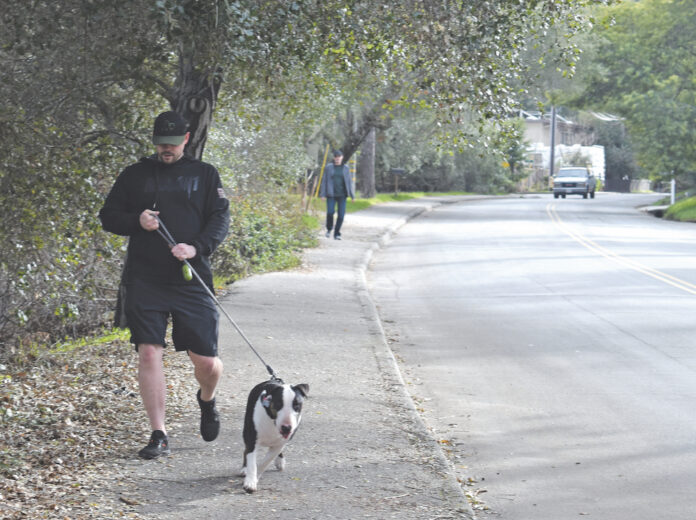The City of Scotts Valley’s Active Transportation Plan reached another milestone as the draft was unveiled at a City Council meeting on Feb. 3.
The plan, presented by Ecology Action’s planner Amelia Conlen, focused heavily on the main arterials Scotts Valley Drive and Mount Hermon Road and proposed many implementations to reach its goal of increasing active transportation by 20 percent.
Scotts Valley Public Works Director Daryl Jordan said the plan is “a funding mechanism to apply for grants” for needed projects.
After its launch in spring 2019, planners reached out to the community for input. They interviewed 588 Scotts Valley residents, more than 5 percent of the 12,000 local residents. Conlen said Ecology Action regards community input as the foundation for the planning process, so staff hosted a public meeting in October of 2019 and launched a project website. It also attended 13 community events, farmers markets, art and wine festivals, food distributions and reached out to large Scotts Valley employers.
Respondents listed missing sidewalks, aggressive drivers, and speed of motor traffic as their top three concerns regarding walking or bicycling. More than 80 percent desired to walk or bike as a part of their daily commute in Scotts Valley.
Overall, the plan proposes many improvements, such as Highway 17 crossings, shared-use paths, sidewalk gap closures, bicycle network improvements, bike parking and pedestrian improvements at intersections. Conlen also presented proposals to adopt a Complete Streets policy, a street tree program and to promote Scotts Valley as a biking destination. Planners took possible future developments into accordance as well, such as the potential Aviza housing development on 440 Kings Road.
Improvements to Mount Hermon Road and Scotts Valley Drive are the focus of the plan.
“They were the top two locations that we received public comments on,” Conlen said. “They are the majority of bike and pedestrian collisions within the city and they are the main routes through town. Scotts Valley is not a grid system. There are not great parallel streets that people can use to get off these two arterials if walking or biking. These are the routes to access schools, shopping, and all major destinations within Scotts Valley.”
Conlen outlined several options for Mount Hermon Road. Amongst proposed improvements were continuing filling sidewalk gaps and to provide curb extensions, green bike lane treatments, median refuge islands, high visibility crosswalks and pedestrian countdown signal heads were amongst proposed improvements. The plan also advocated for condensing motor vehicle lanes from 12 feet to 11 feet, which would allow for a 2-foot buffer with bollards (short vertical posts) separating the bike lane from vehicles. This could be accomplished during Mount Hermon Road’s next repavement and was proposed as an interim concept until the city completes its more ambitious town center road plan.
Conlen presented several options for Scotts Valley Drive as well, such as wider sidewalks, street trees, curb extensions, buffered or separated bike lanes and curb extensions. Like Mount Hermon Road, vehicle lanes could be condensed to 11 feet, providing space for a buffer.
Conlen also proposed a “road diet,” narrowing five vehicle lanes to three, between Quien Sabe Road and Victor Square. The diet would provide 26 feet for bikers, sidewalks, street trees, sidewalk cafes and benches. Using traffic data from 2018, Conlen said that a consultant found that the traffic volumes in that area are low enough that one lane in each direction would be sufficient to accommodate traffic volumes without negative impacts.
“However, more study would be needed before moving forward,” she said.
“Our goal with the Active Transportation Plan is to provide a menu of options that the city can explore going forward, with many requiring more study and community outreach before the city would consider moving forward,” she said. “It’s important to remember that this is a big-picture, long term planning document, and that it takes years to fund, design, and construct active transportation projects.”
After unveiling the plan, locals commented during the meeting, including several residents on Bluebonnet Lane. They were concerned with the recent elimination of some bollards separating traffic from the pedestrian and bike path on Bluebonnet.
“This is a planning document, not engineering, or a developed document,” Jordan said. “There’s so much more detail that we can put into it. There’s many ways to create that safety and we’re not going to know what that looks like until we figure out funds.”
The City Council agreed to review and change the plan with regards to Bluebonnet Lane.
The final plan will be brought back for adoption in late March, Conlen said. Access the ATP Draft Plan on pages 25-103 of the Scotts Valley City Council’s Agenda.









